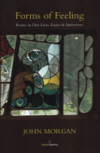Forms of Feeling
This book is ostensibly an essay collection, but poet and creative writing teacher John Morgan has also filled the pages with poems, biographical information, journal entries, book reviews, interviews, and reading and writing instruction. These various elements within the same volume combine to create an intimate portrait of the poet and his spirituality, teaching methods, family life, writing practice, and interactions with nature and place.
This book is ostensibly an essay collection, but poet and creative writing teacher John Morgan has also filled the pages with poems, biographical information, journal entries, book reviews, interviews, and reading and writing instruction. These various elements within the same volume combine to create an intimate portrait of the poet and his spirituality, teaching methods, family life, writing practice, and interactions with nature and place.
Morgan’s credentials include a BA from Harvard, where he studied with Robert Lowell, an MFA from the Iowa Writers Workshop, and several prestigious literary awards and fellowships; however, despite his impressive accomplishments, Morgan frequently reveals his humility, exalting the book’s veracity and the writer’s authority. For instance, in the essay “Why I Am Not a Novelist,” in which he explains his arrival at poetry after two failed attempts to write novels: “You see before you no superhero—just an ordinary, striving, fatherly, husbandly figure, trying somewhat bumblingly to make his way.”
In this expansive portrayal of a poet, his life, and his work, the reader understands that for Morgan, poetry is a way of life. He reveals how writing poetry has helped him emotionally deal with several difficult events, including his wife’s miscarriage. He includes three of the twenty-four sonnets he wrote in response to his son’s sudden, serious, chronic illness to demonstrate the “true sonnet feel of powerful emotions being controlled by form.” He explains his affinity for poetry: “Poems are like messages in bottles hurled into the sea from a cliff and we may never know when one reaches some distant shore and is taken into a reader’s heart.”
Morgan shows a number of his poems in various stages of revision, explaining in detail how and why he made particular changes. He generously shares his philosophy about poetry and includes detailed accounts of his writing process, quoting classic and modern poets as well as his own original work. As a bonus, he suggests several writing exercises.
One of the most instructive essays is a close reading exercise. The essay opens with William Stafford’s poem “Traveling Through the Dark,” which Morgan recommends reading several times before beginning the exercise—a reading guide composed of twelve questions, followed by Morgan’s expansive answers to these questions. These questions encourage the reader to examine word choices, tone, mood, sensory details. I’ve never studied poetry, but I found this exercise helpful to my creative nonfiction writing.
Morgan confesses that during the four years he spent writing his failed novels, he took LSD on two occasions, the second time two weeks after the first. He describes the experiences in explicit, agonizing detail—the terror, hallucinations, physical collapse, and the fear that his mind wouldn’t find its way back. This event becomes a metaphor for the shift in Morgan’s writing focus from novels and fiction to poetry: he converts a short story to a poem, finding his way back, as his mind found its way back from the LSD trip, to the practice of poetry.
Morgan’s letters and journal entries chronicle his journey from his childhood in a Jewish family in New York City to teacher of creative writing graduate students at the University of Alaska Fairbanks. Much of his writing focuses on his strong sense of place and his relationship with Alaska, demonstrated in the two book reviews—one on a book about the catastrophic Exxon-Valdez oil spill and the other on a collection of Koyukon Indian tales. Morgan ends the book with a passage about the importance of place, “the most profound use of which is as a metaphor for the self in its deepest, meditative self-knowing. All places used in this way are mythological and reach between people, across decades, across continents.”
This unique book appeals to a diverse audience. Writers of all genres will find the book informative and instructive as well as entertaining.





